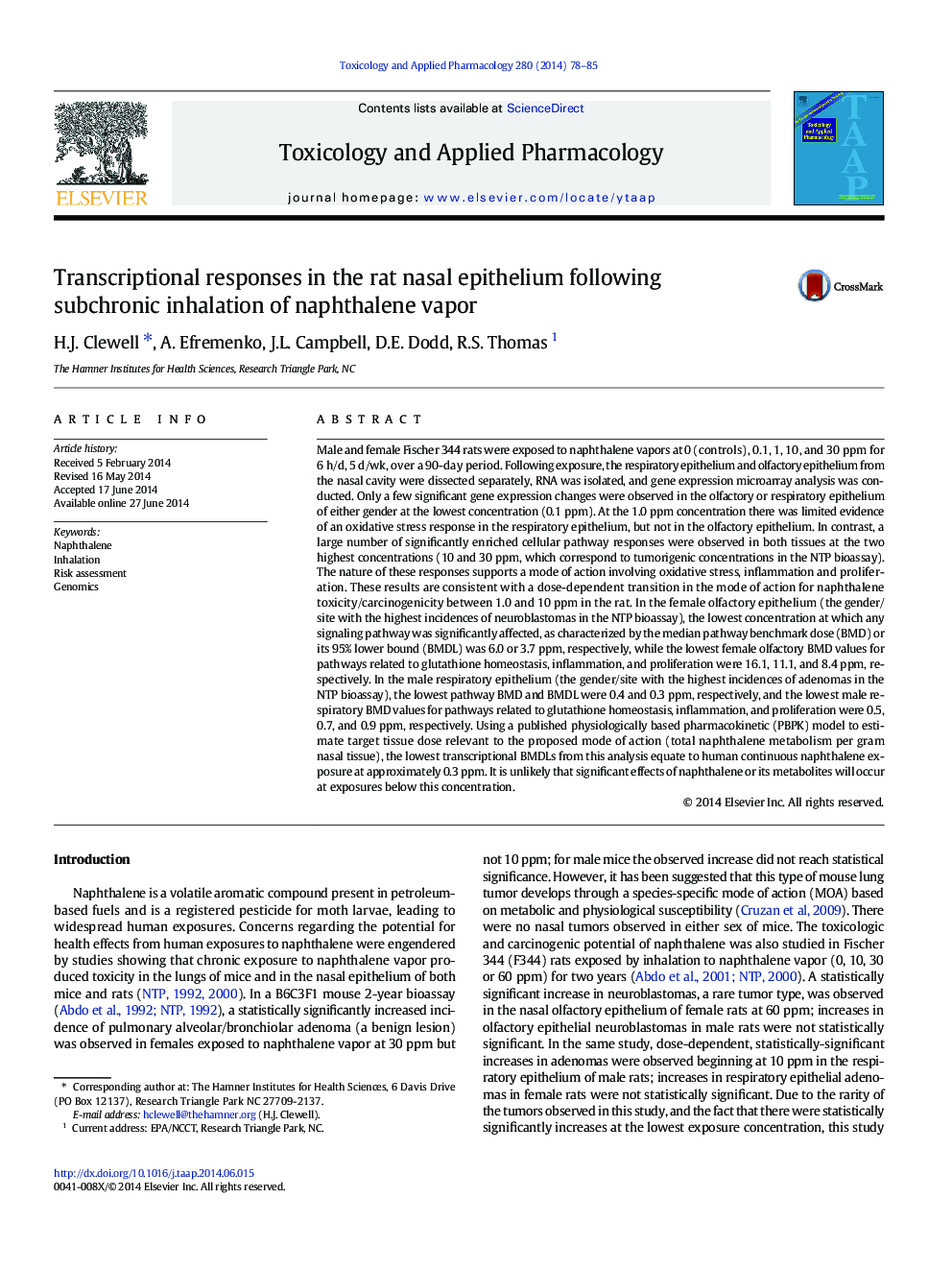| کد مقاله | کد نشریه | سال انتشار | مقاله انگلیسی | نسخه تمام متن |
|---|---|---|---|---|
| 5846192 | 1128461 | 2014 | 8 صفحه PDF | دانلود رایگان |
عنوان انگلیسی مقاله ISI
Transcriptional responses in the rat nasal epithelium following subchronic inhalation of naphthalene vapor
ترجمه فارسی عنوان
پاسخ های ترانسپورتیال در اپیتلیوم بینی موش پس از استنشاق بخار نفتالین
دانلود مقاله + سفارش ترجمه
دانلود مقاله ISI انگلیسی
رایگان برای ایرانیان
کلمات کلیدی
نفتالین، استنشاق، ارزیابی ریسک، ژنومیکس،
موضوعات مرتبط
علوم زیستی و بیوفناوری
علوم محیط زیست
بهداشت، سم شناسی و جهش زایی
چکیده انگلیسی
Male and female Fischer 344 rats were exposed to naphthalene vapors at 0 (controls), 0.1, 1, 10, and 30Â ppm for 6Â h/d, 5 d/wk, over a 90-day period. Following exposure, the respiratory epithelium and olfactory epithelium from the nasal cavity were dissected separately, RNA was isolated, and gene expression microarray analysis was conducted. Only a few significant gene expression changes were observed in the olfactory or respiratory epithelium of either gender at the lowest concentration (0.1Â ppm). At the 1.0Â ppm concentration there was limited evidence of an oxidative stress response in the respiratory epithelium, but not in the olfactory epithelium. In contrast, a large number of significantly enriched cellular pathway responses were observed in both tissues at the two highest concentrations (10 and 30Â ppm, which correspond to tumorigenic concentrations in the NTP bioassay). The nature of these responses supports a mode of action involving oxidative stress, inflammation and proliferation. These results are consistent with a dose-dependent transition in the mode of action for naphthalene toxicity/carcinogenicity between 1.0 and 10Â ppm in the rat. In the female olfactory epithelium (the gender/site with the highest incidences of neuroblastomas in the NTP bioassay), the lowest concentration at which any signaling pathway was significantly affected, as characterized by the median pathway benchmark dose (BMD) or its 95% lower bound (BMDL) was 6.0 or 3.7Â ppm, respectively, while the lowest female olfactory BMD values for pathways related to glutathione homeostasis, inflammation, and proliferation were 16.1, 11.1, and 8.4Â ppm, respectively. In the male respiratory epithelium (the gender/site with the highest incidences of adenomas in the NTP bioassay), the lowest pathway BMD and BMDL were 0.4 and 0.3Â ppm, respectively, and the lowest male respiratory BMD values for pathways related to glutathione homeostasis, inflammation, and proliferation were 0.5, 0.7, and 0.9Â ppm, respectively. Using a published physiologically based pharmacokinetic (PBPK) model to estimate target tissue dose relevant to the proposed mode of action (total naphthalene metabolism per gram nasal tissue), the lowest transcriptional BMDLs from this analysis equate to human continuous naphthalene exposure at approximately 0.3Â ppm. It is unlikely that significant effects of naphthalene or its metabolites will occur at exposures below this concentration.
ناشر
Database: Elsevier - ScienceDirect (ساینس دایرکت)
Journal: Toxicology and Applied Pharmacology - Volume 280, Issue 1, 1 October 2014, Pages 78-85
Journal: Toxicology and Applied Pharmacology - Volume 280, Issue 1, 1 October 2014, Pages 78-85
نویسندگان
H.J. Clewell, A. Efremenko, J.L. Campbell, D.E. Dodd, R.S. Thomas,
